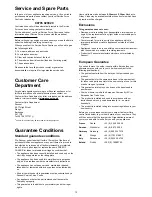
Any electrical work required to install this appliance
should be carried out by a qualified electrician or
competent person.
Any plumbing work required to install this appliance
should be carried out by a qualified plumber or competent
person.
Remove all packaging before positioning the machine.
If possible, position the machine next to a water tap and a
drain.
Water supply connections
This dishwasher must be plumbed into a cold water supply.
The water pressure must be within the limits given in the
technical specifications (page 2).
Your local Water Authority will advise you on the average
mains pressure in your area.
The dishwasher features fill and drain hoses which can be
turned either to the left or the right to suit the installation.
The locknut must be correctly fitted to avoid water leaks.
Do not use, for the connection, old hoses which have
been used in another appliance.
Avoid bends or kinks in the hose which could prevent or slow
down the water supply.
If the machine is connected to new pipes or pipes which have
not been used for a long time, you should run the water for a
few minutes before connecting the inlet hose. This will prevent
deposits of sand or rust clogging the inlet hose filter.
Water outlet hose connection
The end of the drain hose can be connected in the following
ways:
1. To the sink outlet spigot, securing it if necessary with a clip.
2. Hooked over the edge of the sink using the special curved
plastic guide provided.
3. To a stand pipe provided with vent-hole, minimum internal
diameter 4 cm.
The waste connection must be at a height of between 30 cm
(minimum) and 100 cm (maximum) from the bottom of the
dishwasher.
The drain hose can face either to the right or left of the
dishwasher
Ensure the hose is not bent or squashed as this could prevent
or slow down the discharge of water.
The sink plug must not be in place when the machine is
draining as this could cause the water to siphon back into the
machine.
Attention!
Our appliances are supplied with a security device to
protect against the return of dirty water back into the
machine.
If the spigot of your sink has a "no return valve"
incorporated this can prevent the correct draining of your
dishwasher. We advise you therefore to remove it.
If you use a drain hose extension it must be no longer than 2
metres and its internal diameter must be no smaller than the
diameter of the hose provided.
Likewise the internal diameter of the couplings used for
connections to the waste outlet must be no smaller than the
diameter of the hose provided.
Electrical connection
This appliance must be earthed.
The manufacturer declines any responsibility should this
safety measure not be observed.
If the plug that is fitted to your appliance is not suitable for the
socket, it must be cut off and the appropriate plug fitted.
Important
The wires on the mains lead are coloured in accordance with
the following code:
Green and Yellow
- Earth
Blue
- Neutral
Brown
- Live
If you fit your own plug, the colours of the wires in the mains
lead of your appliance may not correspond with the markings
identifying the terminals in your plug.
Proceed as follows:
1. Connect the Green and Yellow (earth) wire to the terminal
in the plug which is marked with the letter "E" or the earth
symbol
or coloured green and yellow.
2. Connect the Blue (neutral) wire to the terminal in the plug
which is marked with the letter "N" or coloured black.
3. Connect the Brown (live) wire to the terminal in the plug
which is marked with the letter "L" or coloured red.
The plug moulded onto the lead incorporates a 13amp BSI362
fuse. Only ASTA or BSI fuses should be used.
The plug must not be used if the fuse cover/carrier is lost. The
cover/carrier is indicated by the coloured insert at the base of
the plug.
A replacement cover/carrier must be obtained from your local
Service Force Centre.
14
Installation instructions
min 30 cm
max 100 cm
min 4 cm
Ø 21
Ø 18
CS09
2
3
1
max 100 cm
CS14
min 30 cm
max 100 cm
+ 2 m max
Ø 18
Ø 21
13
A
CE04
E
N
L


































